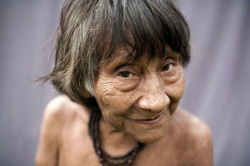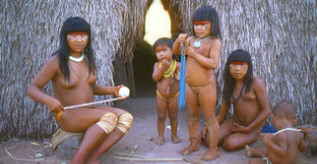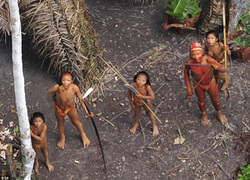Endangered Tribes
On his annual trips to Africa, Mike Sarnitz hunts with the Bushmen and uses
bow & arrow in order to learn from these last hunters and gatherers
The most endangered tribes in the world on a view
On his annual trips to Africa, Mike Sarnitz hunts with the Bushmen and uses
bow & arrow in order to learn from these last hunters and gatherers
The most endangered tribes in the world on a view
Bushmen
The indigenous people of Southern Africa, whose territory spans most areas of South Africa, Zimbabwe, Lesotho, Mozambique, Swaziland, Botswana, Namibia, and Angola, are variously referred to as Bushmen, San, Sho, Basarwa,Kung, or Khwe (see the Nomenclature section for more details). The Bushmen are part of the Khoisan group. Though related to the traditionally pastoral Khoikhoi, they were traditionally hunter-gatherers. Starting in the 1950s, and lasting through the 1990s, they switched to farming as a result of government-mandated modernization programs as well as the increased risks of a hunting and gathering lifestyle in the face of technological development.
There is a significant linguistic difference between the northern Bushmen living between Okavango (Botswana) and Etosha (Namibia), extending into southern Angola on the one hand and the southern group in the central Kalahari towards the Molopo, who are the last remnant of the previously extensive indigenous San of South Africa.
The indigenous people of Southern Africa, whose territory spans most areas of South Africa, Zimbabwe, Lesotho, Mozambique, Swaziland, Botswana, Namibia, and Angola, are variously referred to as Bushmen, San, Sho, Basarwa,Kung, or Khwe (see the Nomenclature section for more details). The Bushmen are part of the Khoisan group. Though related to the traditionally pastoral Khoikhoi, they were traditionally hunter-gatherers. Starting in the 1950s, and lasting through the 1990s, they switched to farming as a result of government-mandated modernization programs as well as the increased risks of a hunting and gathering lifestyle in the face of technological development.
There is a significant linguistic difference between the northern Bushmen living between Okavango (Botswana) and Etosha (Namibia), extending into southern Angola on the one hand and the southern group in the central Kalahari towards the Molopo, who are the last remnant of the previously extensive indigenous San of South Africa.
 Photo © Survival
Photo © Survival
The Awá Tribe
The small tribe of Awá is currently regarded as the Earth’s most endangered tribe as their territory are being invaded by vast groups of illegal loggers, settlers and ranchers. The tribe is regarded as one of the last truly nomadic groups of Brazil with uncontacted numbers estimated to be around 60. Due to the rapdly shrinking forests, the tribes-people are facing a constant threat of extinction. There have even been reports of Brazilian experts referring to the condition as a case of “genocide”.
 photo © returnofthecapturedspirits.com
photo © returnofthecapturedspirits.com
Rio Pardo Indians - Mato Grosso, Brazil
This is another threatened tribe in the western Brazilian Amazon whose lands are being invaded by groups of illegal loggers. Due to such constant encounters, the tribe members are always on the move. This has not only affected their ability to cultivate crops but also affected their population as the women have even stopped giving births.
 photo © Ruedi Suter/Survival
photo © Ruedi Suter/Survival
The Ayoreo-Totobiegosode Indians:
Residing within the vast expanse of the dense Chaco forest from Paraguay to Bolivia and Argentina is the threatened tribe of Ayoreo-Totobiegosode Indians. The Totobiegosode have faced continual invasions of their lands with their greatest threat reportedly being a Brazilian firm, Yaguarete Porá.
 photo © Survival
photo © Survival
Indians between the Napo and Tigre Rivers, Peru:
According to Survival reports, the tribespeople living between the Napo and Tigre Rivers are caught in the middle of Peru’s oil boom.
 photo © gadailynews.com
photo © gadailynews.com
Indians of the Envira River, Peru:
Just like the Awá and the Rio Pardo Indians, the Indians of the Envira River in Peru are facing a constant threat of extinction owing to the invasion of illegal loggers.